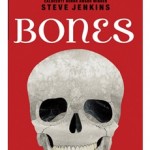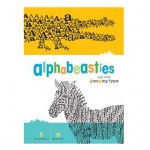Bones: Skeletons and How They Work
I could say, “here’s an informational book that will tickle your funny bone” or “it’s so good it’s scary”, but Bones: Skeletons and How They Work by Steve Jenkins needs no rib-tickling tricks to get kids’ attention. For Halloween or health units, this book is thoroughly engaging. Using cut paper, Jenkins makes incredible illustrations of all kinds of bones to show how structure aids function. Some of the bones are shown actual size, so it’s easy to compare a human skull to that of a baboon, a dog, a parrot, or an armadillo. Some bones are too large to show in actual size, so Jenkins makes the bones to scale. Kids can compare an adult human’s foot bones to the fossil foot bones of a Tyrannosaurus rex! Not only is this book visually a treat, it’s chock-full of “who knew?” facts that kids love: “a giraffe’s neck is as long as a man is tall, but giraffes and humans have the same number of neck bones: seven.”
I love sharing informational books like this with students. With Steve Jenkins’ books, I’m squeezing in the Common Core State Standards of Range of Reading and Key Ideas and Details, I can work interesting books into math and science units, I’m immersing my students in nonfiction, and all the while the kids think they’re just enjoying a good book. Because most of Jenkins’ illustrations are actual size or to scale, you can use Bones: Skeletons and How They Work in a measurement lesson. Kids can estimate how long a bone is and measure it with a ruler. For higher level math, have students measure the to-scale illustrations and multiply to get actual-size measurements.
If you read this book with students around Halloween, it can be a springboard to make some spooky decorations. At enchantedlearning.com, you can print off a human skeleton template for students to cut out and put together with brads to see how all our bones fit. Hang up the skeletons and your decorations are not only scary, they are scientific! For a treat that’s not loaded with sugar, try serving “Bones Dipped in Blood” (pull breadstick dough into bone shapes, bake, and serve with pizza sauce.) To incorporate a bit of technology and to rock it old school, go to YouTube and treat your students to the Schoolhouse Rock video clip of “Them Not-So-Dry Bones”. “Right now there’s a skeleton locked up inside of you!”
For more information, please visit Steve Jenkins’ website: stevejenkinsbooks.com.
Read MoreGrace for President
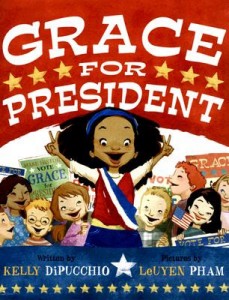 “Red” voters, “blue” voters, undecided voters, here’s one thing we can all agree upon: Grace for President written by Kelly DiPucchio and illustrated by LeUyen Pham wins for Most Fun Picture Book for Early Elementary Students to Explain How the Voting Process Works.
“Red” voters, “blue” voters, undecided voters, here’s one thing we can all agree upon: Grace for President written by Kelly DiPucchio and illustrated by LeUyen Pham wins for Most Fun Picture Book for Early Elementary Students to Explain How the Voting Process Works.
This book gets my vote for so many reasons:
1. When Grace’s teacher shows a poster of all the past American presidents, Grace asks the question so many of us have wondered over the years, “Where are the girls?” Grace decides to “be the change” and run for president. Her teacher encourages her by holding a school election. Hooray for encouraging participation in the democratic process!
2. The language is not watered down, even though this book is aimed at early elementary students. We still learn about electoral votes, representatives, constituents, polls, and rallies, all in ways that make sense to kids. The author’s note at the end gives more information about the Electoral College and how it works. Woohoo for working important information into an entertaining story, and for helping us teach the Craft and Structure Common Core State Standard!
3. Grace runs against a boy, Thomas. Nice kid, but when he calculates the electoral votes and sees that the boys hold more votes than the girls, he assumes the race is his. Thomas doesn’t do much campaigning while Grace goes all out. I love that “even before the election, Grace made good on her promises.” (Don’t you wish all candidates were like Grace?) In the end, a boy casts his votes for Grace because he thinks she is the best person for the job, and Grace wins because of her hard effort, not because of her gender. Yay for focusing on what really matters! (Discuss with your class all the things Grace did to win the election and you’ll be working in the CCSS of Key Ideas and Details, too!)
4. LeUyen Pham’s illustrations include kids from a variety of cultural backgrounds. Woohoo for celebrating the diversity of our nation!
After you share Grace for President with your students, you might find one or more of them become inspired to run for office. Consider creating a position (President of the Week, Commander in Chief of the Line, etc.) for which your students can campaign and run. Talk about voting based on credentials vs. popularity. Students can create posters, give speeches, and cast ballots. If you’d rather not have student elections, consider casting votes in other kinds of elections. Our library is encouraging students to Vote for Books and we used SurveyGizmo to build an online poll (check out our candidates here: orionlibrary.org).
If the talk turns to our current presidential race, TimeforKids online magazine is a fantastic resource for nonpartisan information. In fact, I prefer to get my news on the candidates from places like TimeforKids rather than many adult-targeted news sources because there’s no mudslinging! Now that deserves a huge woohoo!
For more information, visit Kelly’s website at kellydipucchio.com and LeUyen’s website at leuyenpham.com. And remember to vote this November!
Read MoreVote for Books!
Ms Kristen Vote for “Pete the Cat” for Best Picture Book
by: Kris1556
At our library, we wanted to involve our kids in the voting process while promoting reading and integrating technology. So we created our own “Vote for Books” campaign. Our librarians selected five candidates to run in each category: Best Picture Book, Best Chapter Book, and Best Middle School Book. Kids are coming on Oct. 20 and 27 to make campaign posters and campaign video ads. Our local television station ONTV will be here to film students talking about why others should vote for their candidates, or kids can make digital ads like the one shown above (made for free on the Xtranormal website). Campaign videos will run on our website and on our ONTV cable station. Monday, Nov. 5 and Tuesday, Nov. 6 are our Election Days, and anyone can vote (no photo ID required!) for their favorite books. We used Survey Gizmo to put together our polls, so kids can cast their vote in our library or “absentee ballots” can be cast via our website.
It has been so fun to use technology this way to promote great books and to encourage civic engagement. If you’d like your students to get involved in the voting, please feel free to visit our library website: orionlibrary.org. Look over our book choices and discuss them with your students – did we leave one of your favorites off of our list? Make posters or videos for your candidates (send us photos or links and we’ll include them on our website!) and encourage fact-based, polite debate. Most importantly, exercise your right as Americans and vote on Monday, Nov. 5 and Tuesday, Nov. 6 for your candidates. For as President Franklin D. Roosevelt said, “”Nobody will ever deprive the American people of the right to vote except the American people themselves and the only way they could do this is by not voting.”
Can’t see the video clip above? Please visit: Campaign video for “Pete the Cat: I Love My White Shoes
Read MoreAlphabeasties and other Amazing Types
My husband, the illustrious author/illustrator Matt Faulkner, is very intelligent (note his wise choice when picking a spouse). He was also the last kid in his class to learn the alphabet. Matt is very visual, and one of the reasons he had a hard time distinguishing some letters was because they can look so different depending on the font. That’s why Alphabeasties and other Amazing Types by Sharon Werner and Sarah Forss is so terrific. This alphabet book makes animal pictures and alliterative phrases using different typefaces. Uppercase Gs are shown with and without a “beard”, and you’ll see a lowercase g sometimes has a “groovy curl on its head” but sometimes it doesn’t. A gaggle of Gs and gs group together to make a giraffe standing in long blades of grass. The sheep shapes are made of S’s, so the sheep sheared with scissors has a pile of curly S’s at its feet. It’s great to have a book point out that letters can look different in books because of the typeface – “a lowercase a can wear a little hood” or “a lowercase a can be a ball and a stick.” No wonder it earned starred reviews and Parent’s Choice awards. Alphabeasties and other Amazing Types will help all those visual “Picture Smart” learners with letter recognition and the Common Core State Standard of print concepts.
If you have access to computers and printers, let students choose interesting fonts in which to type and print their names. Bring in magazines, newspapers, coupons, etc. for students to cut up and compare letters in different fonts. Students can glue all the a’s on a big A shape, etc., or make alliterative classroom pictures with them by drawing an outline of the animal and letting students glue the corresponding letters onto the shape. An Alphabeasties Amazing Activity Book is available in bookstores along with flashcards. When you’re ready for fun with numbers, check out Werner and Forss’s book Bugs by the Numbers.
For more information about Sharon Werner and Sarah Forss, visit their website at wdw.com
From Cocoa Bean to Chocolate
 If you’re craving engaging nonfiction to share with early elementary students, I have a book that will satisfy the pickiest readers: From Cocoa Bean to Chocolate by Robin Nelson. It is arguably the yummiest title in the “Start to Finish” series by Lerner (although From Milk to Ice Cream sounds pretty good, too!) Simple sentences tell how cocoa beans are made into candy. I love that each page has basic information in bold letters (“Cocoa beans grow”) and then a few short sentences with more information (“A farmer plants many cocoa trees. Hard pods grow on each tree. Inside each pod are seeds called cocoa beans.”) So if you’re reading to the very young, or those with very short attention spans, you can read just the bold sentences, but you have enough information to share with those who are ready for longer text. Great full-page photos make this book easy to share with a large group. Informational text features like a table of contents, an index, and a glossary make this a delicious introduction to nonfiction.
If you’re craving engaging nonfiction to share with early elementary students, I have a book that will satisfy the pickiest readers: From Cocoa Bean to Chocolate by Robin Nelson. It is arguably the yummiest title in the “Start to Finish” series by Lerner (although From Milk to Ice Cream sounds pretty good, too!) Simple sentences tell how cocoa beans are made into candy. I love that each page has basic information in bold letters (“Cocoa beans grow”) and then a few short sentences with more information (“A farmer plants many cocoa trees. Hard pods grow on each tree. Inside each pod are seeds called cocoa beans.”) So if you’re reading to the very young, or those with very short attention spans, you can read just the bold sentences, but you have enough information to share with those who are ready for longer text. Great full-page photos make this book easy to share with a large group. Informational text features like a table of contents, an index, and a glossary make this a delicious introduction to nonfiction.
From Cocoa Bean to Chocolate is terrific to address the Common Core State Standard of Key Ideas and Details in Reading. With your students, use the book to help write out the steps in the cocoa-to-chocolate process on index cards. Students can then shuffle the cards and order the steps correctly on a bulletin board, or you can hang a clothesline for students to pin the steps in order. Include as few or as many steps as suits your class needs. If you have the means, bring in cocoa beans for your students to see and taste (they are a bit pricey, but I found an 8-ounce bag online for less than $10). To incorporate math and graphing skills, taste-test types of chocolate (dark vs. milk, etc.) and graph favorites. From Cocoa Bean to Chocolate makes informational reading sweet!
Read MoreLemonade and Other Poems Squeezed from a Single Word
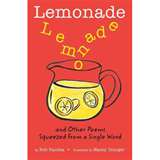 I know, I know, it’s September, we should be discussing fall titles, but here in Michigan it’s a glorious sunny day, perfect for Lemonade and Other Poems Squeezed from a Single Word written by Bob Raczka and illustrated by Nancy Doniger. Using only the letters from a single word, Bob Raczka makes short, sweet poems. (In the book, Raczka and Doniger show the long word, the letters falling, and how the letters rearrange to make new words, but for the sake of brevity I’m tightening the line spaces here. Use your imagination.)
I know, I know, it’s September, we should be discussing fall titles, but here in Michigan it’s a glorious sunny day, perfect for Lemonade and Other Poems Squeezed from a Single Word written by Bob Raczka and illustrated by Nancy Doniger. Using only the letters from a single word, Bob Raczka makes short, sweet poems. (In the book, Raczka and Doniger show the long word, the letters falling, and how the letters rearrange to make new words, but for the sake of brevity I’m tightening the line spaces here. Use your imagination.)
Spaghetti: papa has a pasta appetite he eats heaps
Earthworms: a short storm worms here worms there wear shoes
Share this book with your students and you’ll squeeze in three of your Common Core State Standards for reading: Range of Reading (because you’re sharing poetry), Print Concepts (recognizing all the letters of the alphabet, understanding how letters form words), and Fluency (these simple poems will be read and reread easily). To show how Raczka squeezed poems from words, write one of the words he chose on a large whiteboard. Use magnetic letters to spell the word again below your written word, and then begin rearranging those letters. Encourage your students to call out words they could make, or let them come up and arrange the letters themselves to make new words. Keep a running list on your white board of the words you formed. Now, can your class make a sentence using just those words, or a poem?
Students can use this as a writing prompt in a high-tech or low-tech way. In a large font, you can print off words for students to cut apart into letters they can manipulate, perhaps their names, vocabulary from a science or social studies unit, etc. and see if students can form words, sentences and poems. If you have access to iPads, you can download the Magnetic ABC iPad app (free for all capital letters, $1.99 for lowercase letters, numbers, and symbols). I like this app better than using real magnet letters because you always have as many of each letter as you need, and none of them get lost under the refrigerator or shelves. On the iPad, students can arrange the letters to make words as well, keeping a list of words they’ve made on Notepad ( a free app that comes on the iPad) and using that list to write poems.
Any time of the year, Lemonade and Other Poems Squeezed from a Single Word invites readers in for a refreshing sip of poetry.
For more information, visit Bob Raczka’s website: bobraczka.com or Nancy Doniger’s website: nancydoniger.com.
Read MoreSuryia Swims!
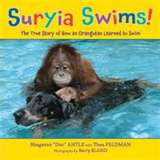 It’s the end of August, so before we pull out the books about apples, pumpkins, and leaves changing color, let’s give one last hurrah to summer with Suryia Swims! How an Orangutan Learned to Swim.
It’s the end of August, so before we pull out the books about apples, pumpkins, and leaves changing color, let’s give one last hurrah to summer with Suryia Swims! How an Orangutan Learned to Swim.
“Their evolutionary history has taught (orangutans) to beware of dangers, such as crocodiles, that lurk in the water. Because of this, the intuition that would have encouraged orangutans to swim never developed.” Orangutans like Suryia don’t swim, but then again, Suryia is not a typical orangutan. He lives in South Carolina at a wildlife preserve called T.I.G.E.R.S. (The Institute for Greatly Endangered and Rare Species) instead of Southeast Asia like his wild counterparts. His best friend is a dog named Roscoe. And when the tigers, the otter, the elephant, and the tapir go swimming in T.I.G.E.R.S. pool, Suryia jumps in, too.
The photographs by Barry Bland are incredible. Suryia cuddles leopard cubs in the water and dives for plastic rings, things an orangutan would typically never do. In the safe wildlife preserve that Bhagavan “Doc” Antle founded, animals don’t have to struggle for survival, so “their intellect and curiosity can grow”. Seeing all the other animals have fun in the water may have encouraged Suryia to overcome his fear, too. Sounds a bit like a good classroom, doesn’t it?
Use this nonfiction picture book to teach the Common Core State Standard of Key Ideas and Details: students retelling the who/what/where/when/why of a text. After you share this book with your students, discuss the information found in the author’s note. Why is it so unusual for Suryia to swim? Why do you think Suryia took the plunge? At our library, we have found that Storyboxes or magnetic Storyboards are great vehicles for retelling. We find puppets or stuffed animals of the characters in the book, or make copies of open-source images and glue old magnets to the back. We put the characters and the book in a center for students to retell or act out the details they’ve learned. Students can use a puppet orangutan and say why he’s afraid of swimming. One by one, students can put Roscoe the dog in a pretend pool, then Bubbles the elephant, Tonks the tiger, the baby bear Ondar, etc. and retell the details of the book. Go to suryiaandroscoe.com to see video clips of this amazing, swimming orangutan and his best animal friend. Suryia Swims! written by Bhagavn “Doc” Antle with Thea Feldman and photographs by Barry Bland will reaffirm for your students that anything is possible!
Read More




